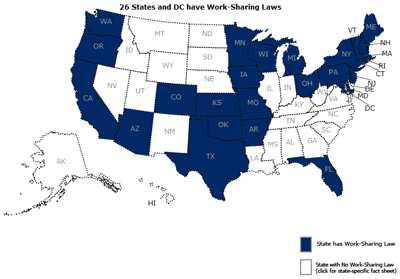Half of States Don’t Offer “Work-Sharing” Benefit to Ease Underemployment and Prevent Layoffs
08 May 2014

According to Federal Reserve Chair Janet Yellen, some 7.4 million people are stuck involuntarily working part-time for economic reasons. That is, they simply cannot find full-time employment.
Meanwhile, the federal government is trying to give away $100 million in grants to states who are willing to set up a safety net to help these workers by ‘topping off’ wages to a full-time equivalent, even during weeks where their hours are reduced by struggling employers. The federal government has expressed willingness to provide this assistance via so-called ‘work-sharing’ programs through 2015.
Even so, the federal government is having trouble giving away money!
The Department of Labor announced the grant program in the summer of 2012, pursuant to the Layoff Prevention Act of 2012. But only two states, Washington and Ohio, have applied for a share of the money. The two states have already received about $6 million. There is a lot of federal money still uncommitted.
At issue: The future of “work-sharing.” Presented as an alternative to layoffs during economic downturns, work-sharing helps businesses keep skilled workers around by kicking in part of their compensation when their hours have to be reduced due to economic conditions. The idea is to keep workers on some sort of stable financial footing until economic conditions recover and they can find full-time work again.
Here’s how it works:
• An hourly (non-exempt) employee normally works a 40-hour work week and earns $500.
• Because of business conditions, the employer cuts his hours by one of the five days normally worked, resulting in a 20 percent reduction.
• Assuming weekly benefit from unemployment insurance of $250, the employee may receive a work-sharing benefit of 20 percent of the usual unemployment benefits – or $50 – in addition to the 32 hours of wages earned.
• The total pay the worker receives is $450.
According to the National Employment Law Foundation – an advocacy group for the unemployed, these programs have “saved” about a half million jobs since the program was implemented. While applications for benefits have declined, thanks to a reduction in layoffs and a gradual increase in hours for those workers affected, there are still about 20,000 workers enrolled in any given week, nationwide.
26 states have work-sharing programs in place now, with structures varying by jurisdiction.
Those states are:
Alabama, Alaska, Delaware, Georgia, Hawaii, Idaho, Illinois, Indiana, Kentucky, Louisiana, Mississippi, Montana, Nebraska, Nevada, New Mexico, North Carolina, North Dakota, South Carolina, South Dakota, Tennessee, Utah, Virginia, West Virginia and Wyoming. (Specific information for each state is available at the link).
What’s the holdup? Federal strings. The feds, as usual, have some stringent requirements that states must meet in order to qualify for the money. Making the necessary changes at the state level requires a lot of legislative heavy lifting, with a number of powerful interest groups on both sides of the move.
According to government data, work-sharing saved half a million jobs between 2008 and 2013. New applications have fallen off as the economy has strengthened, but an average of about 20,000 people a week are still enrolled in the program.
If you think you can benefit from the program – and you aren’t in one of the 24 states listed above, now’s the time to contact your state legislators and let them know you want this.




